Recapping ‘The Jetsons’: Episode 05 – Jetson’s Nite Out
George and Mr. Spacely sneak off to watch the big game, but are caught in the act by Jane on the family’s super-sized television
![]()
 This is the fifth in a 24-part series looking at every episode of “The Jetsons” TV show from the original 1962-63 season.
This is the fifth in a 24-part series looking at every episode of “The Jetsons” TV show from the original 1962-63 season.
The fifth episode of “The Jetsons” aired on Sunday October 21, 1962, and was titled “Jetson’s Nite Out.” The episode revolves around George’s plans to watch the robot football championship game and the various obstacles that get in his way. Eventually, through the scheming of his boss Mr. Spacely, George is able to see the game in person, but is found out as a liar by his wife when he’s shown on TV. The episode gave viewers of 1962 a peek at some often predicted technological advancements of the 21st century: including weather control, disposable consumer goods and gigantic television screens.
Weather Control
After World War II the dream of controlling the weather became somewhat common among future-oriented thinkers. Ideas for weather control came in many forms — from seeding clouds in order to cause precipitation to simply putting roofs over major American cities like New York. The Jetsons’ solution to a rainy day was moving the entire apartment complex up above the clouds by way of a mechanical lift controlled by the building’s superintendent.
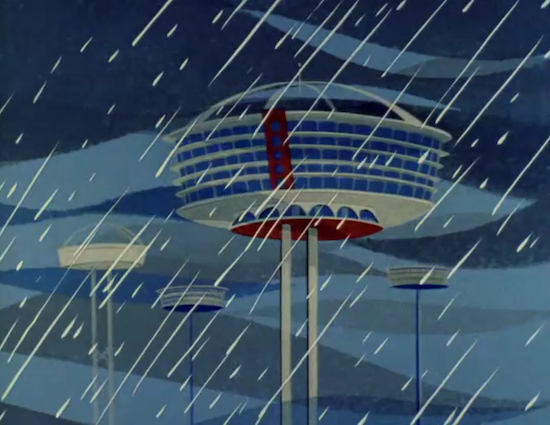
Rain falls on the Jetsons’ apartment complex in this screenshot from the 5th episode
You may recall that we’ve looked at postwar American visions of how weather control could be used as a Cold War weapon. Captain Howard T. Orville was chairman of the President’s Advisory Committee on Weather Control in 1953 and made some dire predictions during the Cold War should the Soviet Union master the science: “if an unfriendly nation solves the problem of weather control and gets into the position to control the large-scale weather patterns before we can, the results could be even more disastrous than nuclear warfare.”
In 1963 Vice President Lyndon Johnson mentioned weather control while making some predictions about the year 2063, and lumped it in with developments in space technology:
Among the space activities in the next one hundred years will probably be: weather control, global communication, global navigation, regular travel of people and freight between places on earth and space stations and the planets, and international policing against space and terrestrial conflicts.
The Jetsons’ version of weather control is of course less militaristic than the visions of the American government in the 1950s and ’60s, but it does give viewers a subtle hint as to why humans have taken to living in the sky.
Disposable Clothes, Disposable Dishes
Another recurring dream of the mid-century futurist was that of abundant disposable goods. From clothes to dinner plates, if it could be manufactured it could be done so affordably in a future of abundance. In this episode we see daughter Judy “doing the dishes” with the touch of a button. They’re first smashed to bits, then swept away with a robotic sweeper arm.
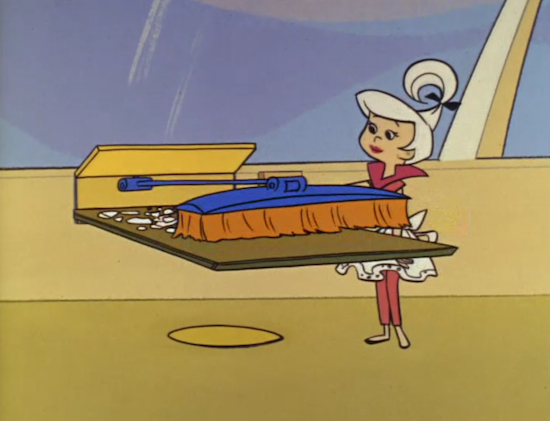
Judy cleans the kitchen table with the touch of a button, removing disposable dishes
Disposable clothes were mentioned in the mid-century futurist classic 1999: Our Hopeful Future by Victor Cohn, as well as in Arthur Radebaugh’s Sunday comic “Closer Than We Think.” A syndicated article which appeared in the October 12, 1961 Evening Capital in Annapolis, Maryland imagined this world of disposable clothes with the headline, “Disposable Clothes Seen Just Around the Corner.”
A research laboratory cuts its big laundry bill way down by sending dirty smocks, coveralls, etc., to the garbage pail. A housewife convinces her husband that her new party dress is a good bargain because she’ll be able to wear it four times before throwing it away. Vacationers, ready to head home, stuff campsite trash and bedding into pillowcases and throw them into the campfire.
Disposable clothes are here – still being tested, but very much alive and kicking.
Interestingly, these many visions of disposable goods rarely mention the potential environmental impact of simply throwing away so much stuff. It wasn’t until Alvin Toffler’s 1970 book Future Shock that mainstream American futurism really began to question the social and environmental costs of a throw-away culture.
Super-sized Television
The idea of gigantic flat screen and projection television may seem less impressive to the people of 2012, but in 1962 it was a revolutionary jump up from bulky televisions of the 1960s. As I’ve noted before, just 3 percent of American households had a color TV in 1962. And the idea of a TV that was more or less an entire wall in your home was extraordinary.
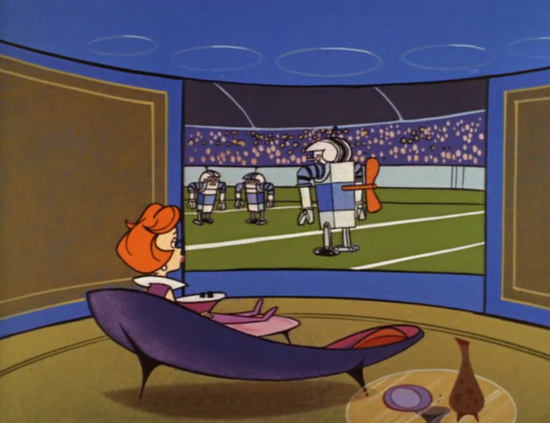
Jane Jetson watches robot football on her wall-sized TV screen
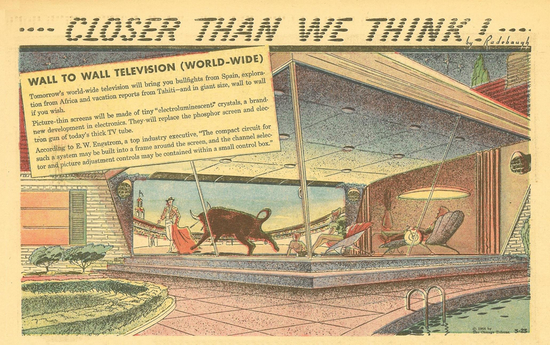
Wall-to-wall TV of the future from the March 23, 1958 edition of the comic Closer Than We Think
The March 23, 1958 edition of Arthur Radebaugh’s Sunday comic strip Closer Than We Think depicted this wall-to-wall television. Rather than football, the American family of the future in this strip is watching a bullfight, hinting at the wide variety of worldwide programming that was surely just over the horizon.
Tomorrow’s world-wide television will bring you bullfights from Spain, exploration from Africa and vacation reports from Tahiti — and in giant size, wall to wall if you wish.
Picture-thin screens will be made of tiny “electroluminescent” crystals, a brand-new development in electronics. They will replace the phosphor screen and electron gun of today’s thick TV tube.
According to E.W. Engstrom, a top industry executive, “The compact circuit for such a system may be built into a frame around the screen, and the channel selector and picture adjustment controls may be contained within a small control box.”
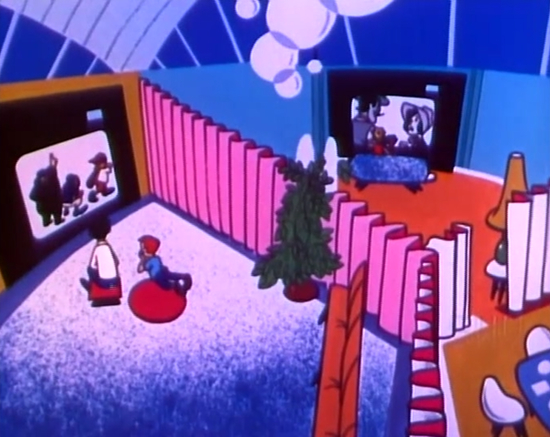
TV sets of the future as depicted in the 1962 Bell Systems film “Talking of Tomorrow”
Again, the ubiquity of screens throughout a home may not be seen as terribly futuristic today, but in 1962 it was positively far out. The screenshot above comes from a 1962 Bell Systems film called “Talking of Tomorrow.” The film shares so many of the Jetsons’ visions for a techno-utopian future, not least of which is the idea that team sports will no doubt be a popular televised spectacle well into the 21st century.
/https://tf-cmsv2-smithsonianmag-media.s3.amazonaws.com/accounts/headshot/matt-novak-240.jpg)
/https://tf-cmsv2-smithsonianmag-media.s3.amazonaws.com/accounts/headshot/matt-novak-240.jpg)